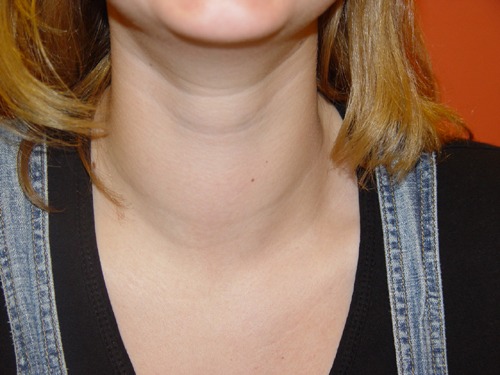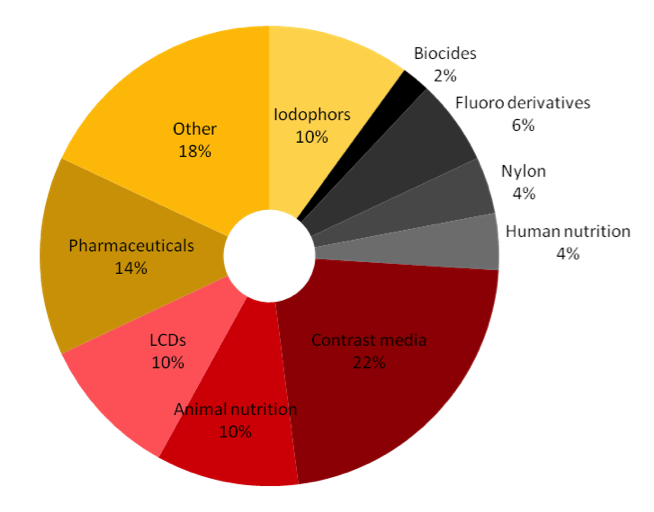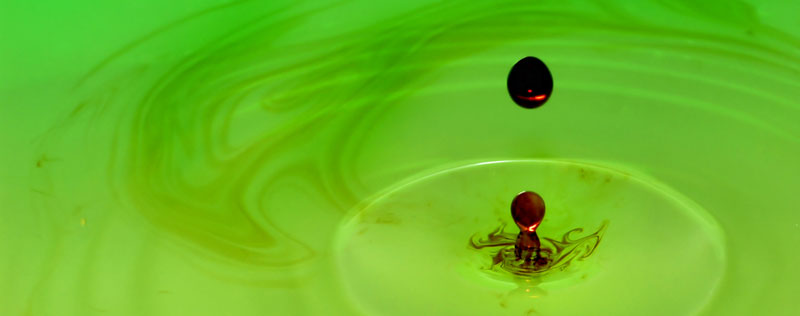Iodine: we can’t live without it
Iodine is one of the most useful medicines of all and its simple, safe and cheap.
It’s fundamental to health of the thyroid, breast, ovary and prostate and when body levels are at sufficiency it becomes a shield against microbes and important toxins. It is the best antibiotic, antiviral and antiseptic of all time. It helps facilitate many endocrine functions.
Discovered in 1811 it was found to have beneficial medicinal properties and for the first half of the 20th century widely used by physicians in the USA.
 The classic sign of iodine deficiency is a “goitre”, an enlarged thryroid which is expanding to try to get every last atom of iodine out of the blood supply. Unfortunately doctors no longer prescribe the mineral to restore deficiencies and the standard treatment for a goitre is destruction or removal of the thyroid. Medical use is mostly as an antiseptic and in some medical drugs and most naturopaths are afraid to use therapeutic amounts. Iodised salt is the only recognised supplement.
The classic sign of iodine deficiency is a “goitre”, an enlarged thryroid which is expanding to try to get every last atom of iodine out of the blood supply. Unfortunately doctors no longer prescribe the mineral to restore deficiencies and the standard treatment for a goitre is destruction or removal of the thyroid. Medical use is mostly as an antiseptic and in some medical drugs and most naturopaths are afraid to use therapeutic amounts. Iodised salt is the only recognised supplement.
In 1997 Guy Abrahams began his “Iodine Project” and started a revolution in iodine use. Many people are using it now, some take heroic doses, there are internet and facebook groups and forums and many testimonials to the benefit of iodine.
Tips for starting the Iodine journey
The essence of iodine therapy is to have a good iodine supplement for daily use, know the best dose for us personally and know what dose to use when sickness strikes.
It usually takes a while to become fully iodine adapted. Over time a deep sense of wellness, mental clarity and energy become a part of life. Benefits will be lifting of brain fog, increased energy, better skin complexion, stronger immunity, better metabolism and blood sugar control.
Always use Iodine with Selenium.
The unit of measure for Iodine is Micrograms (ug) or Milligrams (mg). One gram has 1000 Milligrams, one Milligram has 1000 Micrograms. So 250ug is 1/4mg.
Cautions with Iodine supplementing
Iodine is an essential mineral so is safe by definition.
Please keep in mind that minerals are building blocks for enzymes and their availability decides whether enzyme processes proceed or fail. That is, uncomfortable changes may occur when restoring deficiencies.
Also supplementing iodine may cause Thyroid Stimulating Hormone (TSH) to fluctuate dramatically. Iodine will allow new supply of thyroid hormone which could up-regulate cell receptors and the sodium/iodide symporter with temporary TSH fluctuations. Your doctor may panic but this is not a concern – always start supplementing iodine slowly and stop if symptoms are uncomfortable.
There are two things to be aware of:
First: Selenium goes with iodine and must be taken alongside it.
There are numerous medical articles showing problems with iodine supplementation. The articles don’t mention selenium and the reported problems are consistent with selenium deficiency.
Selenium makes the antioxidant which protects the thyroid from free radical damage when its making thyroid hormone, and selenium is necessary for conversion of thyroid hormone to the active form. Failure to support these functions with the selenium dependent enzymes is likely to allow thyroid problems such as autoimmune damage.
Second: Always start supplementing with a very small dose.
Most people are chronically deficient, many have slow thyroid function and numerous toxins.
Some people think they’re allergic to iodine. We can’t be allergic to an essential mineral but all deficiencies need to be restored carefully.
A starving thyroid may over react. It may feel painful, it may produce a burst of thyroid hormone causing “hyper” feelings – jittery, nervous, wide awake.
Iodine will help liberate and eliminate numerous poisons, particularly fluorides and bromines as well as mercury and lead. Be aware of this and plan for it – good bowel health and motility, ample hydration, nourishing food with ample fats.
Bromide Detox Reactions: twitching eyelids/feet, tingling hands & feet, dark thoughts/emotions, depression/anxiety, mouth & tongue sores, acne like lesions (zinc can help), aches, rash/dermatitis, metallic taste, dry mouth, cherry angiomas, runny nose, headache, lethargy, odd swallowing sensation, body odour, unusual urine colour/odour, increased salivation, kidney pain, breast tenderness.
Dosing Levels of Iodine – average historical use
Recommended Daily Allowance – from 150-250ug
Amount in Iodised Salt (this iodine will ‘sublime’ – evaporate over time). When fresh, about 100ug/gram but after opening it will be around half this amount down to nothing.
Consumed by Japanese who regularly eat sea vegetable – 13.8mg daily. To obtain this amount from fish we would need to eat 5 to 10 kilos daily.
Recommended by Abrahams in The Iodine Project – 12.5mg to 50mg
Dispensed by medical doctors in the 1920’s (single dose) – 770mg
Used by medical doctors up to 1940’s to treat asthma and chronic obstructive pulmonary disease – 1,500 to 10,000mg
For perspective, up to the 1940’s the commonly prescribed “cure-all” dose of 770mg was 4,500 times the current RDA, the upper limit of medical prescribing was 60,000 times the current RDA.
Dosing Levels of Iodine – how much to take
Iodine is extremely safe with a wide therapeutic window. Low doses are effective, excess iodine in a dose will simply be released through mucous membranes and the urine.
Most iodine supplements are liquids, accurate doses are easy to measure. Simply measure by drops and put the required number of drops into a little water for swallowing.
Always start supplementing at a low level. A good number is close to the RDA, about 400ug. Most people don’t notice anything at this amount and it may be increased in weekly steps to a maintenance dose.
If a reaction happens the dose will need to be reduced to about 100ug for a week, then 200ug for another week and so on.
The simple method for accurately taking small doses of iodine is to put 1 drop of your iodine in a glass of water and take a portion e.g. Iosol is 1.8mg per drop, put a drop in a glass of water and take 1/4 of this which is 450ug, a useful starting amount.
Some people react at 1/10 of a drop. If very low doses still cause a reaction the iodine will need to be absorbed through the skin – transdermal application for a couple of months until an oral dose can be tolerated.
High doses are an effective antibiotic. Only for a short period of time and only after becoming used to regular daily supplementing.
Long term high dosing is not beneficial – excess of one mineral will displace other useful minerals.
However in the rare instances of iodine supplementation with no relief from hypothyroidism, higher doses may be needed to overcome sodium/iodide symporter dysfunction due to halide or perchlorate damage.
Higher doses are useful for deeper tissue penetration as an antimicrobial. This will help erode bacterial biofilm but may not penetrate denser collagen enough to be completely effective. If this is your situation please contact clinic for assessment and supportive strategies.
Effective Maintenance Dose – around 5mg daily. Upper limit around 12 mg daily.
A daily intake of around 5mg provides ample iodine for all the body’s needs with a small surplus to allow gradual saturation throughout the body. However many people feel better at moderately higher doses, up to about 12mg.
This is much lower than the 30 – 50gm doses by practitioners and groups using the protocols established by the Iodine Project, but quite enough to be fully effective.
It’s also much more economical with each precious bottle of iodine.
Anti-microbial
 After general anaesthesia, when we drag ourselves back to consciousness and look down at what happened during surgery, we’ll see a line of stitches running across an orange coloured body.
After general anaesthesia, when we drag ourselves back to consciousness and look down at what happened during surgery, we’ll see a line of stitches running across an orange coloured body.
Before the surgeon closed the incision the body cavity was sponged out with povidine iodine and the entire area mopped over after the wound was closed. The orange colour fades over a few days as the iodine is absorbed.
It is effective, safe, non-toxic and bacteria do not develop a resistance to it.
What happens to an iodine sufficient person when they have a large dose of iodine?
After its absorbed there’s nowhere for it to go so it’s immediately excreted. Through the urine and through the mucous membranes. Which creates a similar effect to that described above – a systemic antimicrobial shield is put in place. Quickly and safely in a similar way to an anti-biotic.
What happens with long term high dosages?
Long term high dosing will tend to displace useful minerals and heavy metals.
Wolff-Chaikoff Effect
In 1948 two researchers Wolff and Chaikoff injected large volumes of potassium iodide into the peritoneal (abdominal) cavity of rats and found this blocked the production of thyroid hormone. They did not measure thyroid hormones in the plasma and the rats did not become hypothyroid.
They concluded that iodine in large doses suppressed thyroid function. The reality was a temporary reduction in thyroid hormone production without causing hypothyroidism.
This single trial has been the basis for a systematic reduction in the use of iodine and the medical syndrome which Guy Abraham calls “iodophobia” or ‘fear of iodine’. The clinical use of safe mineral forms of iodine has ceased, Thyroxine has become one of the most prescribed drugs and destruction of the thyroid with radioactive iodine is standard procedure.
Iodine the Element
In primordial times the earth was replete with iodine and all life forms were adapted to having ample amounts. This may be the explanation for the curious fact that iodine is a potent anti-viral, anti-bacterial and anti-fungal agent but does not hurt the beneficial micro-organisms in our gut.
Over eons of time iodine has leached away to the oceans, the land contains very little and our food has none. The only food sources are from the ocean; mainly in sea vegetables, there is almost none in fish.
Iodine is in the group of elements known as “halides”. The other halides are chlorine, fluorine and bromine; iodine is heaviest and is displaced from the body by the others. It is a blue-black metallic solid, the least abundant of the halogens and even less abundant than the “rare earths”.
Sea vegetable such as kelp are the only foods containing therapeutic amounts of iodine but nowadays must be eaten with caution as they may also contain the other halides, particularly bromine.
The main global supply is from a mine in Chile which has a limited remaining life. There isn’t enough iodine to give everyone in the world a bottle of Lugols.

History
Iodine was first discovered during the Napoleonic Wars on the Atlantic coast of France while burning kelp for the ashes as part of saltpetre production for making gunpowder. A blue flame was noticed, the element iodine was isolated in 1813. Like all elements discovered (e.g. mercury) its medical benefits were explored; it was the first element tested in human subjects and recognized to be essential to human health.
Iodine was found to be soluble in alcohol but not in water. In 1829 the French chemist Jean Lugol found that an aqueous (water) solution could be prepared using 5% elemental iodine, 10% potassium iodide and 85% distilled water. To this day Lugols iodine remains one of the most used medicinal forms.
In 1896 the thyroid gland was found to contain large quantities of iodine.
By the 1920’s iodine was as commonly used by doctors as antibiotics are now. It was effective, beneficial and safe.
Forms of Iodine
The days are behind us when a schoolkid could go down town to the pharmacy and buy a few ounces of iodine crystals weighed into a paper bag. Iodine wasn’t scheduled because of the naughty boys (like this writer) who made “touch powder” out of iodine crystals soaked in ammonia and created enormous disturbances at school; apparently iodine has a role in making amphetamine and real explosives.
Iodine is commonly available in solutions of two distinct types; aqueous (water) and spirit (ethanol).
Spirit based iodine solutions are for topical use as disinfectants and toxic if ingested.
Potassium Iodide
Probably the earliest chemical form of iodine to be known and used; it’s medical use dates from 1820. It is the form of iodine added to salt.
Short term high doses were a standard medical practice in the early 20th Century. It was prescribed literally exactly as antibiotics are today, and as effectively. Those old time doctors had a saying – “if ye know not what, where or why, prescribe ye then K and I”.
Long-term large doses of potassium iodide may congest the thyroid gland leading to nodules forming. It may even cause oxidative stress leading to thyroid gland damage, a likely diagnosis being Hashimoto’s Disease.
Povidine Iodine
It is an effective and safe broad spectrum disinfectant/antiseptic. The well known “Betadine” is povidone-iodine. For topical use as an antiseptic and disinfectant only.
Povidone-iodine is a chemical complex of PVP (povidone or polyvinylpyrrolidone), hydrogen iodide and elemental iodine. Bacteria do not develop resistance to it. It is absorbed slowly through soft tissue, making it longer lasting than Tincture of Iodine.
Tincture of Iodine
“Tincture of Iodine” is an antiseptic/disinfectant using elemental iodine with a similar amount of an iodine salt (either sodium or potassium iodide) dissolved in a 50/50 mixture of alcohol and water.
For topical use as an antiseptic and disinfectant only.
Lugols Iodine
The original iodine solution first made in 1829 by the French physician Jean Lugol. It is still used globally as the most popular iodine supplement. Proven safe and beneficial by almost 200 years of therapeutic use.
Lugol determined that elemental iodine could be held as a solution in water if potassium iodide was added. The proportions are 5% elemental iodine, 10% potassium iodide, 85% distilled water. This is called 5% Lugols.
Full strength Lugols (also called 5%Lugols) is 6.25 mg iodine per drop and 2% Lugols has 2.5mg per drop.
Full strength Lugols is becoming difficult to find, it is illegal in the United States.
Iosol Iodine
A proprietary iodine in widespread use for 60 years. It has two forms of iodine in the formulation; elemental iodine extracted from kelp plus ammonium iodide, in a base of vegetable glycerine.
This is the superior iodine supplement. It has a gentle power with excellent absorption.
Ammonium Iodide provides superior absorption to that of Potassium Iodide. The ammonium iodide readily dissociates upon exposure to water to provide a free iodide ion exactly as the body would like to use in metabolism.
Ammonium (NH4) is a by-product of protein metabolism and is also involved in many cellular chemistry reactions necessary for health. Excess ammonium is cleared via the urea cycle. It is not to be confused with Ammonia (NH3) which is a synthesised chemical used in cleaning products and in farming to fix nitrogen in the soil.
Iosol contains 1.8mg iodine per drop.
It is also called “Ammodine” in Australia, short for ammonium-iodine.
SSKI: Saturated Solution Potassium Iodide.
Potassium Iodide (KI) is added to distilled water until no more will dissolve.
The solution contains 50mg iodine per drop.
It is the ideal high dose iodine which should be on every medicine shelf and in every travellers luggage. Take three drops before a plane flight, three drops if suspecting the flu or a “bug”. Ideal to keep kids well when the bugs are circulating at school.
Nascent Iodine
Also known as “atomidine”, The only iodine supplement legally available for retail sale in Australia.
It is an electrically charged single molecule of iodine, readily absorbed and utilised by the body. It contains 400 mcg per drop in a base of grape alcohol.
Nascent Iodine is fairly expensive and because it only contains iodine without iodide it does not seem to have the long term power and benefit of Lugols or Iosol.
However it is a very useful supplement if used at the recommended doses.
Kelp
The classic iodine supplement, readily available in tablets or as a powder.
It is difficult to know just how much iodine is in kelp, but it’s probably around 0.05% of the dried whole plant, or approximately 300mcg per tablet or capsule, which is a reasonable dose for iodine maintenance.
Kelp grows in the ocean and is prone to absorbing pollutants, it may also contain other halogens like Bromine. So it’s a reasonably useful iodine supplement at moderate doses but at higher doses would probably cause more problems than it could solve.
Iodised Salt
The famous standard for iodine replacement.
In 1896 the thyroid gland was chemically analysed and found to contain significant amounts of iodine, which lead to the first large scale campaigns to prevent goitre by using iodised salt; in the United States in 1917 and in Switzerland in 1922.
The benefit to populations of having an easily obtained and reliable iodine supplement cannot be underestimated. However iodised salt does have its negative aspects; the salt is refined, and the iodine evaporates fairly easily.
Iodine Containing Pharmaceuticals
Levothyroxine: also called Thyroxine, the synthetic replacement for thyroid hormone.
Amiodarone: used to regulate irregular cardiac rhythm. May work by blocking thyroid hormone receptors, but has serious effects and may cause significant changes to thyroid activity.


